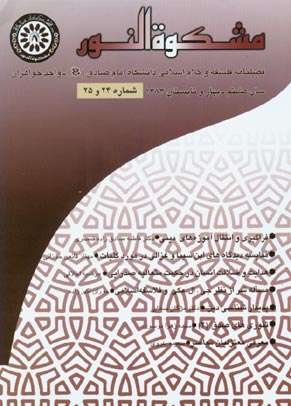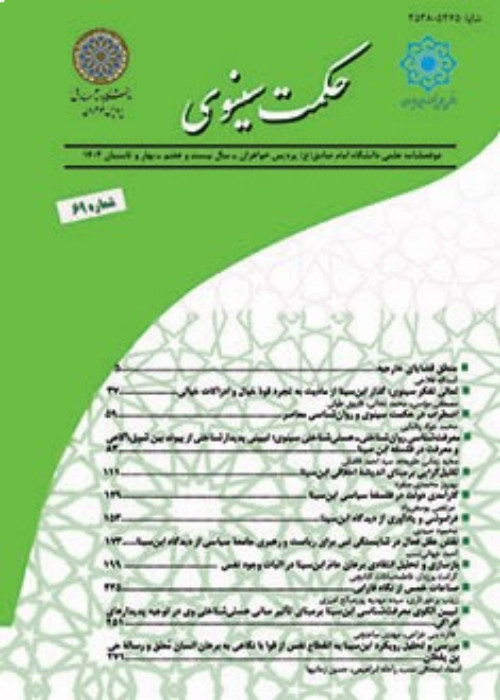فهرست مطالب

نشریه حکمت سینوی
پیاپی 24-25 (بهار و تابستان 1383)
- 144 صفحه، بهای روی جلد: 5,000ريال
- تاریخ انتشار: 1383/05/15
- تعداد عناوین: 7
-
صفحه 5تحصیل عقاید دینی از چه راهی امکان پذیر است؟ آیا می شود برخی از مردم به نحو تقلیدی به خدا، معاد و پیامبر باورهایی داشته باشند؟ آیا تقلید از بزرگان می تواند انسان را به مراتبی از شناخت مبدا و معاد نایل کند؟ بعبارت دیگر، آیا تنها برخی از مردم موظفند درباره اصول و معارف دینی تحقیق نمایند و گروهی دیگر به نام عوام چنین تکلیفی برعهده ندارند؟ از سوی دیگر، تعالیم دینی چگونه و در چه سطحی باید بر مردم ارائه شود؟ آیا اساسا می توان دین را به نحو یکسانی برای همه اقشار جامعه آموزش داد؟ با توجه به ضرورت مخاطب شناسی، عالمان دین و تمامی صاحبان قلم، هنرمندان و فرهنگ سازان هنگام تبلیغ دین و بیان آموزه های دینی فعالیت خود را با کدام یک از سطوح مخاطبان خود تنظیم نمایند؟
-
صفحه 13در مقاله حاضر، مساله «کلی طبیعی» از دیدگاه ابن سینا و غزالی مورد بحث قرار گرفته است. دیدگاه ابن سینا در این مورد، گر چه ادامه نظریه ارسطو در مورد کلیات است، اما از اصطلاحات، تبیین و طرح نویی برخوردار است و می توان گفت نظریه ای جدید و بدیع است. غزالی در مورد کلی طبیعی، ظاهرا همان نظریه ابن سینا را قبول کرده است، اما این با مجموعه عقاید وی سازگار نیست. در عبارات وی نیز گاه گاه ناهماهنگی و ناسازگاری هایی دیده می شود...
کلیدواژگان: کلی منطقی، کلی عقلی، کلی طبیعی، ماهیت به شرط لا، ماهیت لا به شرط، ماهیت به شرط شی -
صفحه 37باطن انسان آمیخته ای از ویژگی های قوای متفاوت حیوانی، سبعی، شیطانی و ملکی است که پیوسته در جنگ و ستیز با یکدیگرند. زیرا هدف نفس تاریک و پست رسیدن به اسفل السافلین و نهایت دوری از حق تعالی؛ و میل روح که از عالم امر و ملکوت است رسیدن به عالم خویش و هم جواری رب العالمین است؛ لذا پیکار با تاریکی های قوای نفسانی و حیوانی و تقویت و تکمیل قوه ملکی و طی مراحل سلوک و رسیدن به مقصد و مقصود ضرورت می یابد...
کلیدواژگان: هدایت و ضلالت، انواع هدایت، مراتب هدایت، هدایت مطلق، فاعل و قابل هدایت، دین و شریعت، تقلید و ریاضت -
صفحه 53جی. ال. مکی فیلسوف ملحد انگلیسی مدعی است باورهای دینی فاقد تکیه گاه عقلانی اند. وی برای اثبات مدعای خویش بین سه قضیه مورد قبول خداشناسان ناسازگاری برقرار می کند. این سه قضیه از این قرار است: «خداوند قادر مطلق است». «خداوند خیر محض است» و «شر وجود دارد». وی با ضمیمه این قضایا به چند قضیه دیگر آن تناقض را نشان می دهد. راه حل های مختلفی را که الهیون در طول تاریخ برای حل مساله شر مطرح کرده اند مورد بررسی قرار داده، اشکالات متعددی بر آنها وارد می نماید...
کلیدواژگان: شرور، خیر، قدرت مطلق خداوند، اختیار انسان، جی، ال، مکی، فلاسفه اسلامی -
صفحه 79یکی از شیوه های دین پژوهی، پدیدار شناسی دین است. این رشته در سده های اخیر رواج فراوانی یافته و دانشمندان بزرگی مانند رودلف اوتو، ژوکوبلیکر، میرچاالیاده و... بر چنین روی آوری به دین تاکید کرده اند.
اینکه پدیدار شناسی چیست و پدیدار شناسی فلسفی کدام است؟ آیا پدیدار شناسی در تحلیل و توصیف علمی امور کار آمد است؟ اموری است که این تحقیق به روشی تحلیلی و البته به اجمال در صدد پاسخگویی به آن است.
کلیدواژگان: پدیدار شناسی، تحویل گرایی، امر قدسی، تعلیق، حیث التفاتی -
صفحه 109سؤال نامناسبی که درباره صدق مطرح می گردد، این است که «صدق چیست». لذا بهتر است با پرسش «صدق یک گزاره (عبارت، جمله، باور) چیست» کار آسانتر شود. هدف این مقاله این است که پیرامون سؤال فوق به تبیین تعدادی از تئوری های صدق و به عبارتی دقیق تر، خانواده نظریات مربوط به صدق بپردازد: تئوری های پیوستگی مشتمل بر نسبتهای پیوستگی بین یک مجموعه از باورهاست. تئوری های مطابقت رویکردی به صدق گزاره ها دارد نه از آن جهت که با گزاره های دیگر چه نسبتی دارد، بلکه از این باب که نسبت آن گزاره با خارج چگونه است، یعنی مطابقت آن با اعیان خارجی و واقع. در تئوری های عملگرایی صدق یک باور از مطابقت آن با واقع برگرفته می شود، اما تاکید می کند که بقای باورها، توسط آزمون تجربه حاصل می شود یعنی مطابقت آن با باورهای دیگر. از نظر تارسکی، صدق برحسب یک نسبت معنایی از صدق پذیری تعریف می شود. در تئوری صدق بیان زائد، «صادق» امری است زائد. زیرا گفتن اینکه «P صادق است» معادل است با گفتن P.
کلیدواژگان: صدق، تئوریهای صدق، صدق عینی، تئوری پیوستگی، تئوری مطابقت، تئوری عملگرایی، تئوری صدق تارسکی، تئوری حشو و زائد (کاهشگرا) -
صفحه 122پیدایش علم کلام در تاریخ اسلام به دلیل عوامل داخلی و خارجی بوده و همین عوامل همواره باعث پویایی این علم بوده اند. همراه با ظهور علم کلام به تناسب تعدد آراء و عقاید کلامی، فرقه های متعدد و متکلمین زیادی ظهور کرده اند که بعضی ز آنها به لحاظ ارائه عقایدی خاص و نیز تسلط به مباحث کلامی و توانایی پاسخگویی به شبهات مخالفین، از اهمیت ویژه ای برخوردارند. از جمله این فرقه ها معتزله و از جمله متکلمین برجسته، قاضی عبدالجبار همدانی است. وجه ممیزه این فرقه کلامی روی آوردن به تفسیر عقلانی آموزه های دینی، اعتقاد به آزادی اختیار انسان، عقیده به حسن و قبح عقلی واعتقاد به عینیت ذات و صفات خداوند می باشد.
کلیدواژگان: سنت، عقل، اسلام خواهی، تجدد خواهی، نو معتزلیان
-
Page 13the present paper discusses the issue of universal natural concepts according to the viewpoints of Avicenna and Al-Ghazali. Although Avicenna’s point of view on the issue is fundamentally based on Aristotle’s theory of universal concepts, it has such new idioms, expressions and features that it is possible to maintain that his theory is quite different. In contrast, when it comes to Al-Ghazali’s view of universal natural concepts, he seemingly approves of Avicenna’s theory of it, which, however, is not compatible with the rest of his theories. In other words, it is sometimes possible to discern certain inconsistencies and incompatibilities in his writings on the issue.
-
Page 37man’s inner self is a combination of various powers, i.e. the animal, human, diabolic and spiritual ones, which are in constant iscordance with each other. This is because the goal of the dark, vile soul is to attain the worst of evils along with utmost distance from God, whereas the soul, which emanates from the heavenly world, Providence, wishes to reach its own world in order to co-dwell with the Lord of the Worlds. Thus, the struggle with the carnal, sensual desires, the reinforcement and perfection of the spiritual power, and the accomplishment of the stages of perfection, eventually make the reaching of the goal and intentions crucial.Sadra sees the human being as a tradesman whose capital is his innate nature, i.e. the same power and talent by means of which he possesses the capability to reach the paths of exaltation and the lodgings of salvation and prosperity. Guidance is only a ladder for ascending to the prosperity and happiness of the Hereafter.By way of looking into Sadra al-Mota‘allehin’s Quranic sources about guidance and reasons why the human being is in need of it, the present paper attempts at pointing out the relevant reasons and factors, as well as the way of getting guidance in Sadra’s teachings. It will hopefully illuminate these issues for the seekers of logic and resolute reason as well as for searchers of the spiritual and the intellectual.
-
Page 53jL. Mackie, a British philosopher and an atheist, claims that religious beliefs do not have any rational grounds. In proving his claim, he puts three theorems, approved of by theists, into mutual opposition. The theorems are as follows:‘God is Omnipotent.’‘God is the Absolute Good.’‘Evil exists.’Drawing on these theorems together with a couple of other theorems, he shows an apparent discrepancy between them. He also puts into scrutiny various solutions that theists have, for ages, presented as solutions for the issue of the existence of the evil, and points out numerous cases of discordance in them.Islamic philosophers, especially those representing the three important schools of thought of Islamic philosophy, have similarly elaborated on the issue of evil’s existence in God’s decree. This paper gives an account of their theories, on the basis of which it responses to J. L. Mackie. In particular, it draws on the theories of the great martyr Morteza Motahari in presenting and dissolving doubts about issues related to the evil.
-
Page 79phenomenology of religion is one of the ways of research into religion. During the last few centuries this field of study has become increasingly popular. Great scholars such as Rudolf Otto, Juco Blecker, and Mircea Eliade among others put emphasis on this outlook on religion.Questions arise as to what phenomenology is, on the one hand, and what philosophical phenomenology is, on the other. Is phenomenology practical in analyzing and explaining things scientifically? The present article attempts to answer the questions in a concise, analytical manner.
-
Page 109the wrong question to ask about truth is “what is truth”. It is better than the task is made easier by asking “what is it for a proposition (statement, sentence, or belief) to be true?” the purpose of this essay is to investigate a number of “theories of truth”- or more accurately, families of views about truth. Coherence theories take truth to consist in relations of coherence among a set of beliefs. Correspondence theories take the truth of a proposition to consist, not in its relations to other propositions, but in its relation to the world, its correspondence to the facts. In the pragmatic theory, the truth of a belief drives from its correspondence with reality, but stressing also that it is manifested by the beliefs survival of test by experience, its coherence with other beliefs. Truth, in tarski’s account, is defined in terms of the semantic relation of satisfaction. The redundancy theory of truth claims that “true” is redundant, for to say that it is true P is equivalent to saying that P.
-
Page 122theosophy has come into existence on the grounds of interior and exterior factors, which in themselves have brought about the dynamic character of this science. Along with the commencement of the science of theosophy, there arose numerous factions headed by men learned in theosophy, some of whom incurred special importance by standing out for their submission of certain principles as well as their skillfulness in theosophical debates and ability of dissolving doubts raised by opponents. Ghazi Abdol Jabbers Hamadani is one of those outstanding learned men of a Mu‘tazili faction. A distinctive feature of this theosophical faction is putting importance on logical explanations of religious teachings, belief in human being’s freedom of will, belief in the good and bad consequences of reaching conclusions logically, as well as belief in the sameness of God’s substance and attributes.Prompted by this important aspect of the Mu‘tazilahs’ work, i.e. assuming a perspective of logic on religious sources, a number of new Islamic thinkers in Arab countries, mainly, are trying today to solve problems that Islam encounters in the modern era. The commencement of the neo-Mu‘tazili movement is manifested in the opinions and thinkings of Mohammad Ahmad Khalafollah and his followers in Egypt. Hasan Hanafi, a disciple of Ahmad Khalafollah, is the only person who has dedicated himself to the compilation, and study, of theosophical viewpoints into systematic collections. Consequently, it is possible to place him and his opinions representing the new Mu‘tazili movement in comparison with those of Abdol Jabbar Hamadani, a representative of the old Mu‘tazili movement. Such a comparison enables us to find out about the relationship between these two Mu‘tazili factions.


